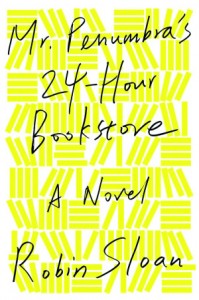“The [bookstore] shelves were packed close together, and it felt like I was standing at the border of a forest – not a friendly California forest, either, but an old Transylvanian forest, a forest full of wolves and witches and dagger-wielding bandits all waiting just beyond moonlight’s reach…Ladders clung to the tall shelves and rolled side to side…They whispered rumors of accidents in the dark.”
 From the first pages to the last, this refreshing, original, imaginative, thoughtful – and often humorous – debut novel kept me glued to the chair, reading as fast as I could while trying to force myself to read more slowly to savor the fun to the utmost. I confess that I have never been a fan of fantasy, and my knowledge of computer science would fit into a URL line, but I was completely charmed by the style of this novel, an unusual mix of ephemera and cutting edge computer science, and I became totally caught up in it – not just for the excitement of the story itself, but for the ideas it presents and the hints it gives of the future of writing itself. On my (short) list of Favorites for the year, Mr. Penumbra’s 24-Hour Bookstore may be every serious reader’s fantasy, a novel in which an innocent and unsuspecting person takes a night job at a bookstore where he inhabits the world of ancient manuscripts and ancient typefaces – only to discover that his seemingly innocuous, middle-of-the-night customers may be part of an exotic cult.
From the first pages to the last, this refreshing, original, imaginative, thoughtful – and often humorous – debut novel kept me glued to the chair, reading as fast as I could while trying to force myself to read more slowly to savor the fun to the utmost. I confess that I have never been a fan of fantasy, and my knowledge of computer science would fit into a URL line, but I was completely charmed by the style of this novel, an unusual mix of ephemera and cutting edge computer science, and I became totally caught up in it – not just for the excitement of the story itself, but for the ideas it presents and the hints it gives of the future of writing itself. On my (short) list of Favorites for the year, Mr. Penumbra’s 24-Hour Bookstore may be every serious reader’s fantasy, a novel in which an innocent and unsuspecting person takes a night job at a bookstore where he inhabits the world of ancient manuscripts and ancient typefaces – only to discover that his seemingly innocuous, middle-of-the-night customers may be part of an exotic cult.

The mysteries of the bookstore come to life and keep on coming and coming for the next three hundred engrossing pages, carrying the reader along for a wild ride, eventually through cyberspace. Do not think, however, that this is a “wizardy” kind of novel with magic and spells – unless you believe that the computer is magic – for this novel is also a kind of homage to the wonders of the computer and the new knowledge it can unlock for those who seek it.
Clay Jannon, out of work in San Francisco and desperate for a job, applies for work at Mr. Penumbra’s 24-Hour Bookshop from the hours of ten o’clock p.m. to six o’clock a.m., his only “qualification” being that Mr. Penumbra approves of his favori te book, actually a trilogy called The Dragon-Song Chronicles. Hired on the spot, he finds himself working nights next door to a strip joint in a tiny, but very tall building which displays a few used contemporary books in the front, on the first floor, while every available inch behind that display, and rising for three stories, is packed with what Clay calls “the Waybacklist,” ancient, esoteric books, most of them hand-made. He quickly learns that his few customers always arrive carrying one old book which they want to exchange for a different book from the Waybacklist.
te book, actually a trilogy called The Dragon-Song Chronicles. Hired on the spot, he finds himself working nights next door to a strip joint in a tiny, but very tall building which displays a few used contemporary books in the front, on the first floor, while every available inch behind that display, and rising for three stories, is packed with what Clay calls “the Waybacklist,” ancient, esoteric books, most of them hand-made. He quickly learns that his few customers always arrive carrying one old book which they want to exchange for a different book from the Waybacklist.
When they make the exchange, Clay must record each transaction into an old ledger, including the time, the customer’s appearance, his state of mind, how he asks for the book, how he receives it, and whether he is injured. If he is wearing something unusual, like a sprig of rosemary in his hat, that must also be recorded. The “sale” is recorded, and the customer disappears. Finally overcome by curiosity about these strange people and their strange books, he disobeys Mr. Penumbra’s injunction and opens one of these books. Though they are all written in Roman letters, they “aren’t really words at all. The pages are just long runs of letters—an undifferentiated jumble.”

Google Headquarters, Mountain View, CA
On slow nights, Clay amuses himself by creating a computerized model of the bookstore in 3D, using a program of “data visualization.” Identifying each of his customers by a different color in this 3D model, he creates a line for each. He already knows that the location of the strange, possibly coded, books they take out is not alphabetical and that they are shelved by aisle and shelf numbers, but he is curious, so he also includes the location of the book the customer is returning and the location of the book he takes out as he is creating his model. When Clay begins to see a pattern of overlapping colors, he is stunned, and he concludes that the customers and Penumbra himself are members of a secret cult connected to six-hundred-year-old books.
The book really gets going when he gets some computer geek friends to apply their skills in his quest to unearth the store’s secrets. Neel Shah, a young millionaire entrepreneur, will help Clay by acting as “the warrior.” Kat Potente, an expert in singularity who works for Google, will act as “the wizard.” And Clay himself will be “the rogue.” Together, and with help from their hacker friends throughout the world, the three set out on a quest to learn the carefully kept secrets of the bookstore, using some of Google’s cutting edge computer programs and many different kinds of computer languages. Knowledge of the past, as seen in the “Wayba cklist” in Penumbra’s store, in libraries, and in archives around the world may be interpreted in completely new ways, with new insights for the future, when the awe-inspiring magic of computer programming is applied to them, an interesting take on an old theme. Some of the biggest questions they ask are: Who owns this bookstore and who is in charge of the whole operation? What is its goal and how does it survive, since sales are not important? Why was Clay’s favorite book, Clark Moffat’s Dragon-Song Chronicles, instrumental in his hiring? What, exactly, is the cult looking for? And how have they been able to exist as a highly motivated group for over six hundred years?
cklist” in Penumbra’s store, in libraries, and in archives around the world may be interpreted in completely new ways, with new insights for the future, when the awe-inspiring magic of computer programming is applied to them, an interesting take on an old theme. Some of the biggest questions they ask are: Who owns this bookstore and who is in charge of the whole operation? What is its goal and how does it survive, since sales are not important? Why was Clay’s favorite book, Clark Moffat’s Dragon-Song Chronicles, instrumental in his hiring? What, exactly, is the cult looking for? And how have they been able to exist as a highly motivated group for over six hundred years?
Despite all the emphasis on computers and on seemingly arcane languages of all kinds, the true emphasis of the novel is on people, and that is where the book’s overwhelming charm lies. The characters are young and enthusiastic, and readers will identify with their search for knowledge and connection, even to the point at which they question the very nature of life and death. “How can you stand it that our lives are so short, Clay?” one asks. Even more importantly for readers, the author’s own ability to see humor as a very real part of existence is refreshing and life-affirming. I wish I could give more examples of just how captivating this book is, as it looks for answers, but to do so would risk spoilers, and the book is too good and too much fun to risk that. Suffice it to say, that if the description of the novel that I have given here intrigues you at all, the real novel, with all its stimulating detail and its unique twists and turns of plot will leave you breathless. Among the top books on my Favorite lists for 2012.
Photos, in order: The author’s photo is found on http://www.theverge.com
The stacks at the bookstore may resemble those of the Cincinatti Public Library, 1874, from http://tywkiwdbi.blogspot.com
The headquarters of Google in Mountain View, CA, appears on http://untappedcities.com
Clay visits a bar called The Dolphin and Anchor, and its logo becomes familiar during the novel. Festina Lente, “Make Haste Slowly,” also reappears throughout the novel. From http://gandalf.it
ARC: Graywolf
